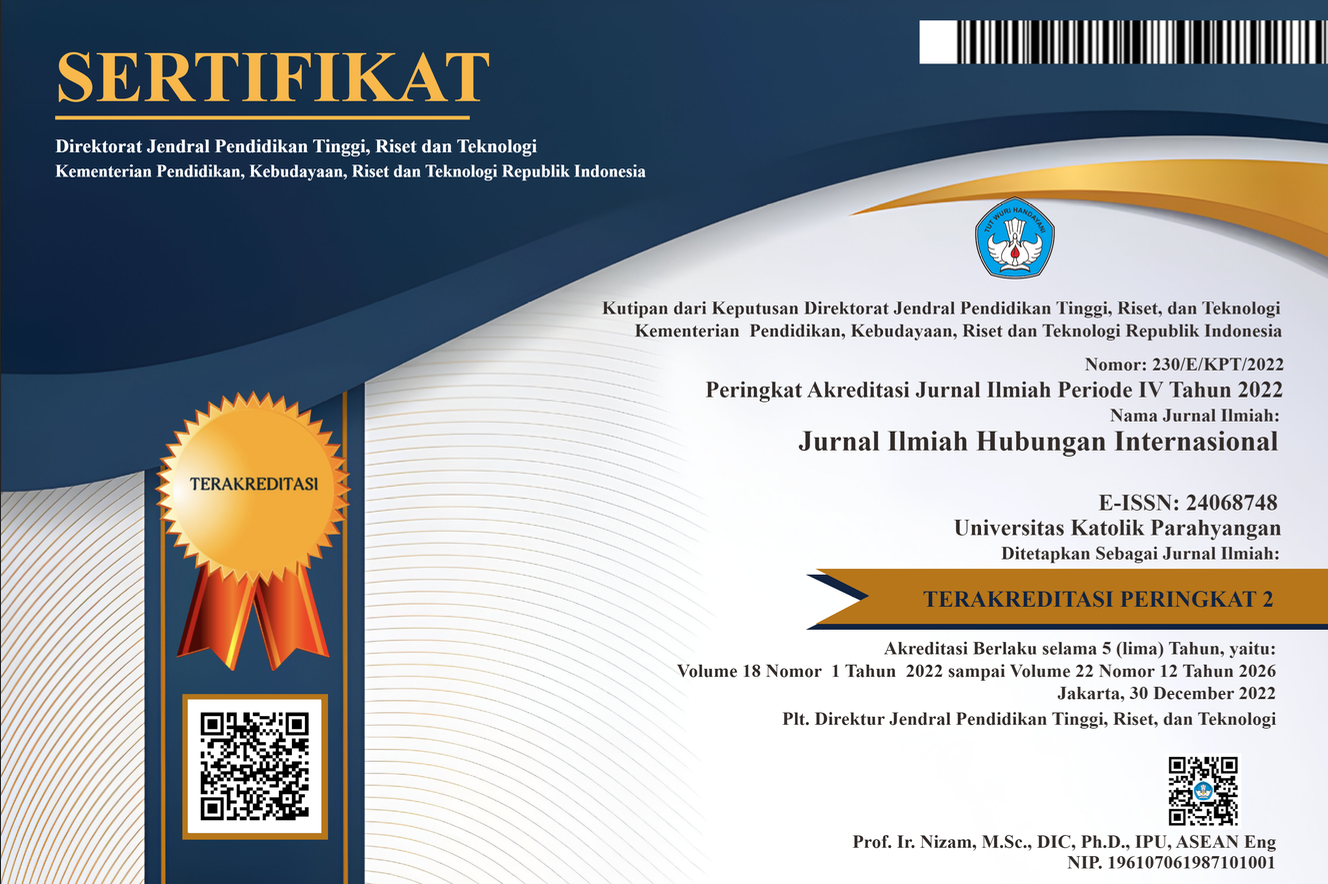Tiga Model Promosi Demokrasi Menurut Lavenex dan Schimmelfennig: Kontribusi Uni Eropa dalam Peningkatan Demokrasi di Myanmar
DOI:
https://doi.org/10.26593/jihi.v17i1.3543.121-137Keywords:
model promosi demokrasi Uni Eropa, aktor normatif, MyanmarAbstract
Transisi politik di tahun 2011 mendorong Myanmar untuk menjadi negara yang lebih demokratis. Pemilihan umum pada tahun 2010 telah mengubah sistem pemerintahan Myanmar dari dominasi militer junta menuju pemerintahan sipil di bawah Presiden terpilih, U Thein Sein. Kondisi ini mendorong Myanmar untuk melakukan perbaikan kualitas demokrasi dengan segera. Hal ini juga dilihat sebagai kesempatan bagi Uni Eropa sebagai aktor normatif untuk mempromosikan norma-norma demokrasi dan sampai batas tertentu, memberikan kontribusi untuk peningkatan demokrasi di Myanmar. Menggunakan metodologi kualitatif, penelitian ini bertujuan untuk memeriksa sejauh mana kontribusi Uni Eropa dalam promosi demokrasi telah membawa peningkatan demokrasi di Myanmar dengan berpedoman pada tiga model promosi demokrasi, yakni linkage, leverage, dan governance. Penelitian ini juga bermaksud untuk menentukan model mana yang dianggap paling efektif bagi Uni Eropa untuk peningkatan demokrasi di Myanmar. Berdasarkan penelitian ini, dapat dikatakan bahwa Uni Eropa telah berkontribusi dalam peningkatan demokrasi dimana model linkage dan governance dianggap sebagai cara paling efektif untuk mempromosikan demokrasi di negara tersebut. Namun, model leverage dianggap sulit untuk digunakan dalam implementasi promosi demokrasi di Myanmar. Beberapa komponen dalam model ini tidak dapat diaplikasikan sepenuhnya ketika berbicara tentang persyaratan politik sebagai instrumen untuk promosi demokrasi. Hal ini dikarenakan oleh sejauh ini apa yang telah dilakukan oleh Uni Eropa terhadap Myanmar tidak memberlakukan persyaratan politik.
Kata kunci: model promosi demokrasi Uni Eropa; aktor normatif; Myanmar
References
Buku
Aung, A (2013). Promoting Democracy in Myanmar: Political Party Capacity Building. Singapore: Institute for Security and Development Policy.
Lall, M (2016). Understanding Reform in Myanmar: People and Society in the Wake of Military Rule. London: C. Hurst and Co Ltd.
Jurnal
Du Rocher, S. (2013). “How Does the Past Shape the Present? The EU Policy towards Myanmar in Inter-Regional Context”, European Journal of East Asian Studies, 12, 191-216.
Egregatau, R (2009). “Intra-European Bargaining and the ‘Tower of Babel’ EU Approach to the Burmese Conundrum”. East Asia, 27(1), 15-33.
Kingsbury, D. (2014). “Political Transition in Myanmar: Prospects and Problems”, Asian Politics and Policy, 6(3), 351-373.
Levenex, S dan Frank Schimmelfennig. (2009). “EU Rules beyond EU Borders: Theorizing External Governance in European Politics”, Journal of European Public Policy, 16(6), 791-812.
Levenex, S dan Frank Schimmelfennig. (2011). “EU Democracy Promotion in the Neighbourhood: from Leverage to Governance?”, Democratization,18 (4), 885-909.
Than, M. (2015). “Myanmar in 2014: Great Expectations Unfulfilled”, Asian Survey, 55(1), 184-191.
Turnell, S. (2011). “Myanmar’s Fifty Year Authoritarian Trap”, Journal of International Affairs, 65(1), 79-90.
Turnell, S. (2011). “Myanmar in 2010: Doors Open, Doors Close”, Asian Survey, 51(1), 148-154.
Tesis
Höhn, H. (2016). The Role of European Union in the democratization of post-military regimes. A case study on the role of European Union in the democratization of Myanmar (Master thesis). https://openaccess.leidenuniv.nl/bitstream/handle/1887/43537/Thesis%20Hannah%20H%C3%B6hn.pdf?sequence=1. Accessed 22 July 2019.
Artikel Online
Bandone, Anete. (2016). “Promoting Democracy and Observing Elections”, European Parliament. http://www.europarl.europa.eu/atyourservice/en/displayFtu.html?ftuId=FTU_6.4.2.html. Diakses 1 January 2017.
Council of the European Union. (2013). “Council Conclusion on the Comprehensive Framework for the European Union’s Policy and Support to Myanmar/Burma”. Europa. https://www.consilium.europa.eu/uedocs/cms_data/docs/pressdata/EN/foraff/138272.pdf. Diakses 15 November 2016.
EEAS. (2013). “Joint EU Development Partners’ Transitional Strategy for Myanmar 2014-2016”. Europa. http://eeas.europa.eu/archives/delegations/myanmar/documents/eu_myanmar/joint-eu-development-partners-transitional-strategy-for-myanmar-2014-2016_en.pdf. Diakses 15 November 2016.
EEAS. (2015). “EU Deploys Election Observation Mission to Myanmar”. Europa. https://eeas.europa.eu/headquarters/headquarters-homepage/5909/eu-deploys-election-observation-mission-to-myanmar_en. Diakses 4 Januari 2016.
EEAS. (2016). “Election Observation Missions (EUEOMs)”, Europa. https://eeas.europa.eu/topics/election-observation-missions-eueoms/421/election-observation-missions-eueoms_en. Diakses 10 Januari 2017.
EEAS. (2016). “Myanmar (Burma) and the EU”. Europa. https://eeas.europa.eu/delegations/myanmar-burma/1569/myanmar-burma-and-eu_en. Diakses 10 Januari 2017.
European Commission. (2016). “Building Partnership for Changes in Developing Countries: Myanmar/Burma”. Europa. http://ec.europa.eu/europeaid/countries/myanmarburma_en. Diakses 16 November 2016.
European Commission. (2016). “Element for an EU strategy vis-à-vis Myanmar/Burma: A Special Partnership for Democracy, Peace, and Prosperity”. EEAS. http://eeas.europa.eu/archives/docs/myanmar/docs/join_2016_24_f1_communication_from_commission_to_inst_en_v5_p1_849592.pdf. Diakses 15 November 2016.
European Parliament. (2015). “Democracy Support”, Europarl. http://www.europarl.europa.eu/about-parliament/en/democracy-and-human-rights. Diakses 4 Januari 2017.
European Parliament. (2016). “Good Governance in EU External Relations: What Role for Development Policy in a Changing International Context?”. Europarl. http://www.europarl.europa.eu/RegData/etudes/STUD/2016/578012/EXPO_STU(2016)578012_EN.pdf. Diakses 7 Januari 2017.
Freedom House. (2011). “Myanmar: Freedom in the World 2011”. Freedom House. https://freedomhouse.org/report/freedom-world/2011/burma. Diakses 24 Juli 2019.
Freedom House. (2012). “Myanmar: Freedom in the World 2012”. Freedom House. https://freedomhouse.org/report/freedom-world/2012/burma. Diakses 24 Juli 2019.
Freedom House. (2013). “Myanmar: Freedom in the World 2013”. Freedom House. https://freedomhouse.org/report/freedom-world/2013/burma. Diakses 24 Juli 2019.
Freedom House. (2014). “Myanmar: Freedom in the World 2014”. Freedom House. https://freedomhouse.org/report/freedom-world/2014/myanmar. Diakses 24 Juli 2019.
Freedom House. (2015). “Myanmar: Freedom in the World 2015”. Freedom House. https://freedomhouse.org/report/freedom-world/2015/myanmar. Diakses. 24 Juli 2019.
Freedom House. (2016). “Myanmar: Freedom in the World 2016”. Freedom House. https://freedomhouse.org/report/freedom-world/2016/myanmar. Diakses 24 Juli 2019.
Freedom House. (2019). “Myanmar: Freedom in the World 2018”. Freedom House. https://freedomhouse.org/report/freedom-world/2018/myanmar. Diakses 25 Juli 2019.
Downloads
Published
How to Cite
Issue
Section
License
Copyright (c) 2021 Jurnal Ilmiah Hubungan Internasional

This work is licensed under a Creative Commons Attribution 4.0 International License.
This journal uses Creative Commons license (CC BY). We allow readers to read, download, copy, distribute, print, search, or link to the full texts of its articles and allow readers to use them for any other lawful purpose. The author must be aware that the article copyrights will be fully transferred to Jurnal Ilmiah Hubungan Internasional only if the article is accepted to be published in the journal through signing of the Copyrights Transfer Agreement. Authors are allowed to resend their manuscript to another journal or intentionally withdraw the manuscript only if both parties (JIHI and Authors) have agreed on the related issue. Once the manuscript has been published, authors are allowed to use their published article under Jurnal Ilmiah Hubungan Internasional copyrights.








